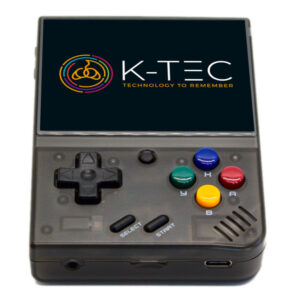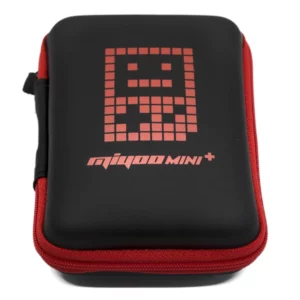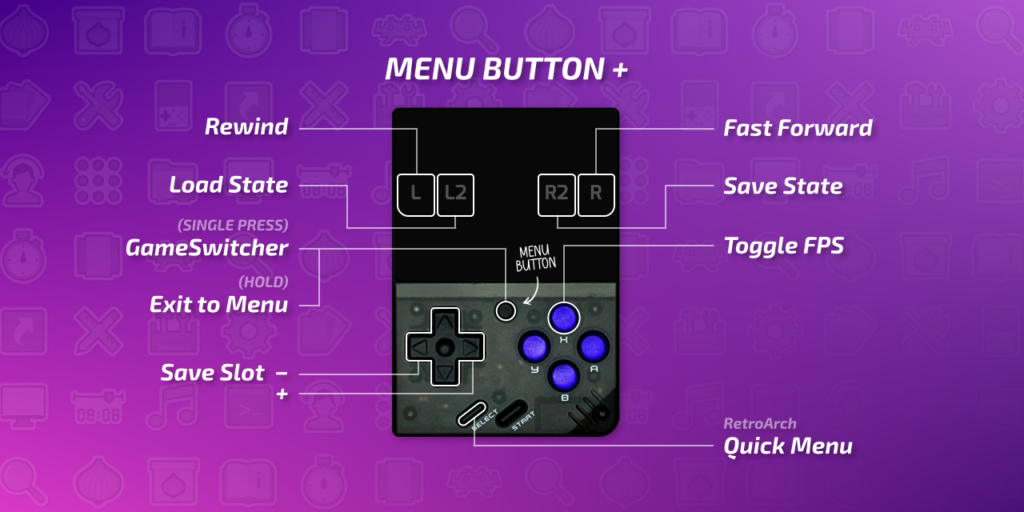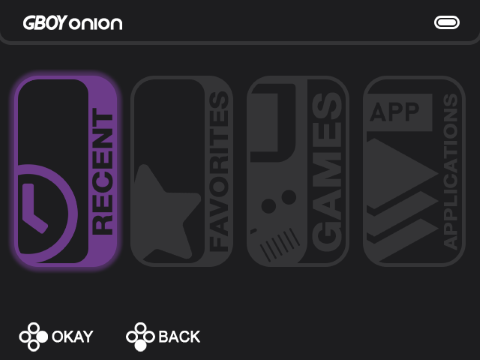-
 Miyoo Mini Plus handheld, with optional speaker upgradePrice range: £79.90 through £99.90
Miyoo Mini Plus handheld, with optional speaker upgradePrice range: £79.90 through £99.90 -
 Protective case for Miyoo Mini Plus£12.90
Protective case for Miyoo Mini Plus£12.90
Miyoo Mini or Miyoo Mini Plus?
This guide is for the Miyoo Mini Plus. If it’s the Miyoo Mini you’re looking for, head over to our Miyoo Mini user guide.
- K-TEC enhancements
- Hints
- Powering on the device
- Turning off the device
- Sleep
- Navigate between systems
- Navigate through a game list
- Quitting a game
- Hotkeys
- Favourites
- On-screen keyboard (for home computer systems)
- ZX Spectrum
- Famicom Disk System (FDS)
- Fast-Forward and Rewind
- Autosave & save-states
- Ports
- Pico-8 and Tic-80
- Setting the clock for Pokemon games
- Switching themes
- Show the Retroarch menu
- GameSwitcher (this is clever)
- Guest mode
- Glossary
K-TEC enhancements
We have used our expertise to tune the configuration of your Miyoo handheld. If you discover other tips or configurations that enhance your experience, please use the contact form to let us know. Here’s a list of the changes we’ve made.
MicroSD card
The microSD cards that Miyoo usually supplies with its handhelds are unbranded and we are not satisfied with their reliability. Therefore, we ship these devices with a brand-name microSD card.
We are so confident about the quality of this card that we provide a lifetime guarantee.
It’s important to make a backup
Even with the lifetime guarantee we give our microSD cards, it is still recommended that you backup your card(s) as soon as you receive your device. See How to backup your retro handheld’s microSD card(s)
Firmware
We have replaced the stock firmware with the OnionOS custom firmware. In our testing, OnionOS provided excellent balance between ease of use and performance. We have further refined the configuration of the firmware with settings specific to the Miyoo Mini+.

Aspect ratio
We have configured OnionOS to use the aspect ratio of the original consoles, preventing games from appearing squashed.
Rewind
We have enabled the Rewind feature for emulators that have enough performance. This can allow you to undo a small fail. See Fast forward and rewind for details.
PlayStation
We have optimized the PlayStation emulator configuration for smoother game-play.
Ports
We have configured Ports (games that run natively on the device, without emulation) so that they’re ready to go.
Hints
Powering on the device
Hold the POWER button for a few seconds.
Turning off the device
Hold the POWER button for a few seconds. Your device will now power down safely. If a game is open, your Miyoo Mini+ will automatically create a save state before shutting down1. When you next start up your handheld, it will boot straight into the game and continue from that save state.
A few systems do no support save-states (e.g. ARCADE, Pico-8, SCUMMVM, some ports). For these, you have to rely on in-game saves.
Hard shutdown
If the device crashes, and the above method doesn’t work, a hard shutdown can be performed by holding POWER for 10 seconds.
This method should only be used as a last resort as it risks data corruption.
Note
Your Miyoo device is a handheld computer and, as such, should be powered down in a safe manner. Otherwise, there is a risk of data corruption.
Sleep
Your Miyoo handheld can be put into sleep mode with a short press of POWER. If you press the power button again, the device will quickly return to the state it was in before entering sleep mode.
Note
This is only a light sleep mode and still drains the battery. We do not recommend using it for long periods of time.
Navigate between systems
Most of the systems supported by this device can be found in the Games section. The Expert section contains systems that are more experimental. When using emulators from this section, the games you play may be a little more prone to crash. We’ve included them because we feel that what they add to your gaming experience is worth the lesser stability.
Navigate through a game list
To speed up the process of scrolling through a game list, use L1 and R1 to move a page at a time.
You may also find it convenient to use the GameSwitcher mode to find your most recently played games. See below.
Quitting a game
Press the FUNCTION button. A short press will take you into GameSwitcher mode where you can select from any of your recently played games (more detail below). A long press will take you back to the main system menu. In both cases, a save-state will be generated and will start from that point the next time you play.
See the GameSwitcher section below for more detail on this functionality.
If you power down the device with a game still running, it will automatically create a save state while it switches off. When you next power on your handheld, it will boot straight into the game and continue from that save-state.
Some systems (e.g. ARCADE, Pico-8, SCUMMVM, some ports) have limited support for GameSwitcher mode and do not work quite as described above. Some will not create a save-state. Some require you to use the FUNCTION + SELECT hotkey to bring up the Retroarch menu, then press B, then scroll down to Quit RetroArch.
Hotkeys
FUNCTION/MENU button
The FUNCTION button is the small, circular button in the middle of the device. The OnionOS documentation calls this the MENU button. The following hotkeys work when pressed together with the FUNCTION button.

| Action | Hotkey |
| Create save-state | R2 |
| Load previous save-state | L2 |
| Fast-forward (toggle) | R1 |
| Rewind | L1 |
| RetroArch menu | SELECT |
Additional hotkeys, not used in combination with the FUNCTION button.
| Action | Hotkey |
| Brightness up | SELECT + R2 |
| Brightness down | SELECT + L2 |
See https://github.com/OnionUI/Onion/wiki/Global-Shortcuts for more.
Favourites
You can add a game to the Favorites section by pressing the SELECT button and choosing Add to favorites.
On-screen keyboard (for home computer systems)
Home computers – such as the Amiga, Commodore 64, Amstrad CPC, and ZX Spectrum – included a keyboard. Games for these systems often require keyboard input actually to start the game-play or to choose joystick mode.
To bring up the on-screen keyboard, for most systems, press SELECT. For the Amstrad CPC, press R1.
If the system seems to be waiting for you to do something, try bringing up the on-screen keyboard and pressing SPACE or RETURN/ENTER.
If a game asks for an input method, we recommend that you choose Joystick or, in the case of the ZX Spectrum, Kempston.
ZX Spectrum
Changing the emulated input device
The default is Kempston and this works well most of the time. However, there are a few games that didn’t support the Kempston joystick. To get you started, you can download a zip file we’ve prepared (this will be updated periodically). Extract the contents and put the files in Saves\CurrentProfile\config\remaps\fuse on the SD card. For those games which still need this configuration, follow these steps:
- In-game, press
FUNCTION + SELECT2 to bring up theRetroArchmenu - go to
Controls -> Manage Remap Filesand chooseSave Game Remap File(this means that the change will be specific to this game) - back up a menu level pressing
B - go to
Port 1 Controls, then choose theDevice Type(Cursor Joystick, Sinclair Joystick, etc.) - close the
RetroArchmenu withFUNCTION + SELECT2
The change has now been saved and should take effect straight away.
Mapping the Miyoo Mini Plus buttons
Some games need more than just joystick input. To get you started, you can download a zip file we’ve prepared (this will be updated periodically). Extract the contents and put the files in Saves\CurrentProfile\config\fuse on the SD card. For those games which still require buttons to be mapped to keyboard inputs, follow these steps:
- In-game, press
FUNCTION + SELECT2 to bring up theRetroArchmenu - go to
Core Options -> Manage Core Optionsand chooseSave Game Options(this means that the changes will be specific to this game) - back up a menu level to
Core Optionsby pressingB - select each button you want to map and choose the corresponding ZX Spectrum input
- close the
RetroArchmenu withFUNCTION + SELECT2
The changes have now been saved and should take effect straight away.
Do not map the SELECT button. Otherwise, you may not be able to quit the game.
Famicom Disk System (FDS)
Famicom Disk System games often require you to change discs. Use the following input sequence to do so:
R1to eject the current discL1to select side BR1to load side B
Fast-Forward and Rewind
Your Miyoo Mini Plus, with OnionOS, allows you to Fast-Forward or Rewind games.
To Fast-Forward, press FUNCTION + R12. This toggles on Fast-Forward mode and can breeze past sections of games that seem to move too slowly. To return to normal speed, press FUNCTION + R12 again.
Sometimes you may wish to Rewind the action in a game to undo a quick fail. Press and hold FUNCTION + L12.
Not enabled on all consoles
Fast-Forward and Rewind are enabled on most systems, but there are exceptions; such as the PlayStation, Amiga, CPS3, GBA, MSX, NeoGeo-CD, Virtual Boy, SCUMMVM, ZX Spectrum, and Pico-8, where there would be an adverse effect on performance.
Autosave & save-states
On most systems, when quitting a game, it will automatically create a save-state3. When next launching the game it will start the action at the same point.
Also, you can create a save-state at any moment of your choosing – press FUNCTION + R22. To re-load that save-state, press FUNCTION + L22. This can be helpful when dealing with a tricky boss.
Ports
Ports are games that run natively on your Miyoo Mini Plus, without the use of an emulator. This means that games can run more smoothly and with better performance.
Pico-8 and Tic-80
Pico-8 and Tic-80 are Fantasy Consoles. These aim to create the experience of retro-gaming without the need to emulate a real hardware console.
A fantasy console is like a regular console, but without the inconvenience of actual hardware. PICO-8 has everything else that makes a console a console: machine specifications and display format, development tools, design culture, distribution platform, community and playership. It is similar to a retro game emulator, but for a machine that never existed.
zep, “What is a Fantasy Console?”, https://www.lexaloffle.com/pico-8.php?page=faq
It’s remarkable what some game developers can do within the constraints of these fantasy consoles, and their games are worth checking out. A great example is Celeste, originally made for Pico-8, and is included with your device.
Setting the clock for Pokemon games
The Miyoo Mini Plus does not feature a Real-Time Clock (RTC). It compensates for this by adding 4 hours to the time upon every reboot.
For games that may require finer control over the stored time, such as Pokemon games, you can use the Clock app. Set the time and date to whatever you wish. Again, 4 hours will be added when you next start your device.
Switching themes
Your Miyoo Mini Plus comes with a range of themes. You can choose your preferred theme by running App -> Themes.
If your chosen theme features background music, its volume level can be configured in the Settings menu.

Show the Retroarch menu
Press the FUNCTION + SELECT2 buttons when playing a game that uses a RetroArch core. You can adjust many settings here, but OnionOS has done a good job of optimizing these for you.
You can also see the RetroArch menu by running the RetroArch item in the App section.
GameSwitcher (this is clever)
The GameSwitcher is designed to be the central user interface of Onion.
https://github.com/OnionUI/Onion/wiki/Features#gameswitcher
Press the FUNCTION button to enter GameSwitcher mode. From here, you can resume one of your recently played games (use LEFT/RIGHT on the D-PAD to choose).
If you enter GameSwitcher mode while a game is running, a save-state will be created automatically. The game will resume from that point the next time it’s played (either from GameSwitcher or a game-list).
To remove a game from the GameSwitcher list, press X.
To exit GameSwitcher mode, press B.
A few systems have limited support for GameSwitcher mode. Either they will not create a save-state (you’ll have to rely on in-game saves) or their games will not appear in GameSwitcher selection screen at all. These systems include ARCADE, Pico-8, SCUMMVM, and some ports.
Guest mode
If want to let someone else use your Miyoo Mini Plus, but you’re concerned they might mess up your save points or configuration, you can put the device in Guest mode.
Run App -> Guest mode. Your guest can now play games without overwriting your save states or settings.
To return the device to normal, just run App -> Guest mode again.
Glossary
- OnionOS
- This is the Operating System that runs on your Miyoo retro handheld device. It provides numerous improvements to the stock firmware.
- Retroarch
- Retroarch provides most of the cores/emulators that run games. The Retroarch menu is used to configure its cores.
- Core
- A Core is an emulator that has been adapted to work with Retroarch.
- Emulator
- An emulator allows your device to pretend that it’s a different device. For instance, the PCSX4ALL emulator enables your Miyoo retro handheld to pretend that it’s a PlayStation and run games designed for the PS1.